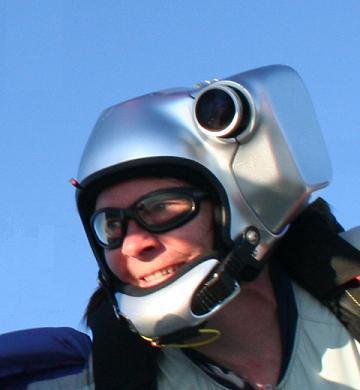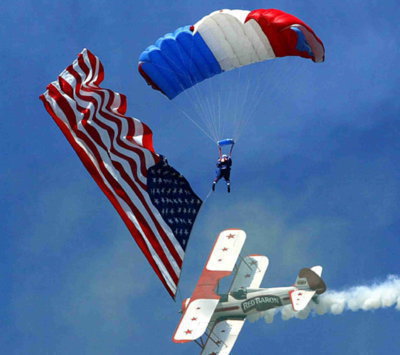Recommended Posts
nigel99 151
Quote
Interesting chart. I assume that having a higher cutaway force reduces the chance of an accidental cutaway with a D ring style handle. I would worry that a fabric handle could bunch up or twist in such a way that it is difficult to use - but I've only seen the photos. What benefit do they have over a metal D ring?
I don't think the higher cutaway force is designed in there on purpose, it's more of a negative influence from the mini-risers.
Fabric loop handles are on most tandems these days, they don't seem to bunch up or get twisted, what they do is give ya a large easy to see, grasp and operate handle.
My 'newest' rig (two years old) came with a fabric loop cut-away handle, but I changed it out to one of those pillows with the finger pockets...only because jumping demos, my hands are moving around quite a bit deploying chest mounted smoke, pyro or flags.
Didn't want to hook the larger loop accidentally.
I didn't mean to imply that the higher cutaway force was an intentional design parameter. I am aware that it is a negative and was trying to note a possible "unintentional benefit" with regards to snagging.
Experienced jumper - someone who has made mistakes more often than I have and lived.
JerryBaumchen 1,075
Hi Jim,
A question for you:
You've had enough cutaways to know; do you think that you would/could actually get your fingers into that finger pocket.
Just asking . . .
JerryBaumchen
A question for you:
Quoteone of those pillows with the finger pockets
You've had enough cutaways to know; do you think that you would/could actually get your fingers into that finger pocket.
Just asking . . .
JerryBaumchen
labrys 0
I have a cloth loop handle and am very comfortable with it. As others have said, they aren't floppy and don't tend to bunch up. I suppose it is slightly more likely to fold under the main lift web than a pillow, but its also easy to hook fingers through it to reduce the chance it will slip out of a gloved, cold, or injured hand. By its nature, the "peel" part of the cutaway happens almost naturally with grasping the loop.
As far as using a regular reserve handle on the right side....I guess I would rather have different tools with different feels for the 2 jobs. The loop lays flat and isn't as rigid or heavy as a metal ring too.
As far as using a regular reserve handle on the right side....I guess I would rather have different tools with different feels for the 2 jobs. The loop lays flat and isn't as rigid or heavy as a metal ring too.
Owned by Remi #?
QuoteHi Jim,
A question for you:Quoteone of those pillows with the finger pockets
You've had enough cutaways to know; do you think that you would/could actually get your fingers into that finger pocket.
Just asking . . .
JerryBaumchen
I wouldn't bet the ranch on it Jerry, I have hands like catchers mitts AND I wear gloves every jump.
I played with it in the hanging harness when I went with that set-up and to be honest, a couple of fingers did go into the little pocket most of the time just grabbing the handle, but what I did like is the fact it's shaped different than the old-style straight twinkie and tappers down inboard so it lays flat and is too big to tuck under..on me anyway.
Seemed easier to grab, and being wider than long felt like I had some 'mechanical' advantage regarding peeling the fuzz.
~ If you choke a Smurf, what color does it turn? ~
I'm seeing comments form experienced people that worry me.
"I would consider such a handle for my cutaway if it had a greater distinction from my reserve...."
"Of course it is nice to have the handles feel different to avoid using the wrong one."
"I guess I would rather have different tools with different feels for the 2 jobs."
I'm having trouble understanding why "feel" and "different tool" is important to a jumper that knows cutaway location and reserve deployment location like the back of their hand.
The only reason I can think of right now is in the case of a very violent mal where the harness gets twisted so radically that you would have to "feel" that you had the reserve deployment handle in your hand when you should be "feeling" the cutaway handle. Is that correct?
Also,
I assume that this comment relates to a dislodged cutaway handle?
"I would consider such a handle for my cutaway if it had a greater distinction from my reserve...."
"Of course it is nice to have the handles feel different to avoid using the wrong one."
"I guess I would rather have different tools with different feels for the 2 jobs."
I'm having trouble understanding why "feel" and "different tool" is important to a jumper that knows cutaway location and reserve deployment location like the back of their hand.
The only reason I can think of right now is in the case of a very violent mal where the harness gets twisted so radically that you would have to "feel" that you had the reserve deployment handle in your hand when you should be "feeling" the cutaway handle. Is that correct?
Also,
I assume that this comment relates to a dislodged cutaway handle?
Quotethe weight of a metal handle has been thought of as a potential problem in that it might activate from...
1) being blown around by wind (when the 3-ring white loop isn't loaded) or
2) from opening shock.
My reality and yours are quite different.
I think we're all Bozos on this bus.
Falcon5232, SCS8170, SCSA353, POPS9398, DS239
I think we're all Bozos on this bus.
Falcon5232, SCS8170, SCSA353, POPS9398, DS239






Share this post
Link to post
Share on other sites